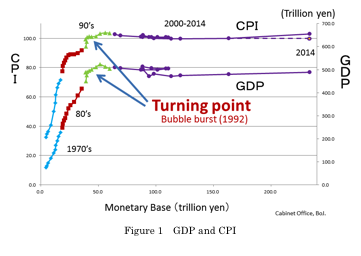The Japanese economy enjoyed high growth until the early 1990s, but thereafter has fallen into secular stagnation for two decades (Figure 1). The USA and the EU have also faced similar situations. Traditional theories regard them as temporary phenomena, and economic policies based on them had little effect. For example, monetary expansions were previously effective but now are not. A theory of secular stagnation is urgently required.

We introduce various aspects of human behavior into a dynamic setting and give a new theory of secular stagnation. The validity of such human behavior is examined using econometric methods and economic experiments. Economic policies and institutional reforms required in secular stagnation are also examined.
Purpose and Background of the Research
Research Methods
We conduct questionnaire survey and construct longitudinal panel data to detect people’s preferences for liquidity and financial assets, relative preferences for wealth over consumption, hyperbolic time discounting, etc. By incorporating those insights into a dynamic framework, we then examine the mechanism of secular stagnation. The effects of various policies are also theoretically analyzed. In secular stagnation an economy suffers from underutilization of economic resources. To find a way to utilize them, we apply the analytical tools from mechanism design theory, public economics and industrial organization. For example, we characterize the optimal algorithm that is applicable to a range of issues, such as housing, urbanization, energy, and medical, that are inherent to matured societies.
Expected Research Achievements and Scientific Significance
Traditional theories suggest monetary and fiscal policies to recover full employment in the short run and emphasize the importance of efficiency-enhancing policies. However, during the stagnation phase they have had very little impact. These experiences suggest that not the conventional policy set but a new policy set is required to deal with the situation. This project is expected to identify the cause of Japan’s stagnation and provide potential remedies for it, which fundamentally differ from the ones suggested by traditional theories. While we focus on the Japanese stagnation, it also gives some relevance and crucial insight for other developed countries. Some emerging ones, such as China and Korea, also seem to have started experiencing similar problems. This project will provide a useful prescription for stagnation of those countries as well.
